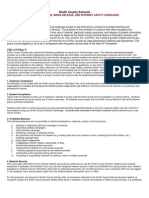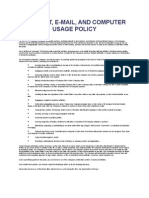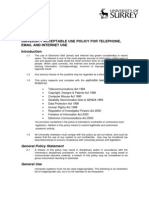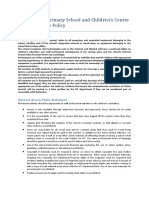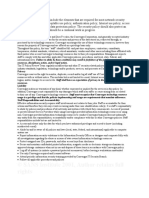Code of Product2
Code of Product2
Uploaded by
Akinyelure Labo OlanrewajuCopyright:
Available Formats
Code of Product2
Code of Product2
Uploaded by
Akinyelure Labo OlanrewajuOriginal Description:
Copyright
Available Formats
Share this document
Did you find this document useful?
Is this content inappropriate?
Copyright:
Available Formats
Code of Product2
Code of Product2
Uploaded by
Akinyelure Labo OlanrewajuCopyright:
Available Formats
Code of practice Scope
This policy applies to all users of Griffith University Information Technology resources regardless of your relationship with the University and irrespective of whether those resources are accessed on or off-campus.
Rationale
Information Technology resources are essential for accomplishing Griffith University's mission of pursuing excellence in teaching and learning, research and community service. Members of the University community are granted shared access to these resources, which must be used and managed responsibly to ensure their integrity, security and availability for appropriate educational and business activities. This IT Code of Practice provides guidance to authorised users for the appropriate use of the University's Information Technology resources.
Statement
Within this IT Code of Practice, Information Technology resources include but are not limited to all standalone or networked computers, hand held devices, all forms of communication equipment, and software owned or leased by the University, including, but not limited to externally hosted applications, for example, email, blogs and social networking sites. This IT Code of Practice is intended to operate within, and be consistent with, existing State and Commonwealth Law, and University law and policies in areas such as sexual harassment, discrimination, equal opportunity, freedom of information, copyright, defamation, discipline and misconduct. It is intended to encourage responsible action and good judgement and to protect privacy. Sanctions will be enforced if you act irresponsibly and disregard your obligations to other users, or to the University as the provider of Information Technology resources. Inappropriate use of University provided Information Technology resources may also result in suspension, expulsion, termination of employment, legal action, or other disciplinary action.
Procedures
Determination of responsibilities
It is your responsibility to become familiar with the rules governing use of the University's Information Technology resources. Users who are authorised to permit other persons to use the University's Information Technology resources must ensure that those persons are made aware of the rules governing use of the
University's Information Technology resources and have them sign or otherwise acknowledge that they will carry out their responsibilities under these rules. Users learning of any violation of any of this IT Code of Practice must bring this matter to the attention of an appropriate officer (e.g. head of element, supervisor, lecturer, and Information Services staff) within the University without delay.
Authorised access
Use of equipment, software and access to the Internet via the University IT resources is provisioned conditionally to those with proper authorisation. University staff and authorised associated persons may be provided with Internet Access for University purposes upon authorisation from relevant faculty or Business Unit (e.g., Head of School/Office Director or nominee). Students receive authorisation upon enrolment at Griffith University. Responsibility and accountability for IT security is the shared responsibility of all users. You will be held responsible for all activities which originate from your account. It is your responsibility to ensure that your passwords, accounts, software and data are adequately secured. If you know or suspect that another person has gained unauthorised access to your account, you must immediately notify the Division of Information Services on 3735 5555. You must not use any means, electronic, social engineering or otherwise, to discover others' passwords.
Appropriate Use
Griffith University technology resources and infrastructure including, but not limited to, desktop computers, laptops, tablets, smartphones, intranet, internet access, wireless network, telephone system, web services, instant messaging, social media and email services may only be used for University purposes and limited personal use, as outlined below.
Statutory Requirements
You must not use the University IT resources to violate or breach any Local, State, Commonwealth or International Law. All information, data or files created, downloaded or stored by users while employed or enrolled at the University can be monitored and subject to investigation. All electronic messages are official documents, subject to the same laws as any other form of correspondence. They are subject to statutory record keeping requirements and can be subpoenaed during legal processes.
Limited Personal Use
Limited personal use is the use of University IT resources to support activities that do not directly relate to University employment or studies. Examples of limited personal use include researching holidays, checking personal emails or social media. Limited personal use must not require substantial expenditure of time, adversely affect University IT resources or breach the Universitys Code of Conduct. Where personal use adversely affects University business, the user may be asked to minimise their personal use.
Prohibited Activities
The University allows its staff to use IT resources for limited extracurricular or non-work-related activities. These activities must not be illegal or potentially bring the University into disrepute, and they must not negatively impact the University's IT infrastructure. Activities which are prohibited include, but are not limited to, the use of Griffith IT resources to do the following:
support or promote political campaigns, candidates, legislation or ballot issues; send mass messages of a commercial, political, lobbying or fundraising nature; forward electronic "petitions", or to ask recipients to forward messages; send anonymous messages; solicit support (financial or otherwise) for charity, or special causes not connected with a Griffith University effort; send unverified public service announcements (such as virus alerts, unsafe products, lost and found, etc.). access websites, peer-to-peer services, bit torrent services, drop-box services, FTP servers etc to send/upload or receive/download for printing and/or distribution any copyrighted materials including with limitation, music, movies, photographs, printed materials, or any other proprietary or protected information. any activities for private business, personal gain or profit.
Offensive and Illegal Material
You should not use the University IT resources to create, download, distribute, store or display any offensive or illegal material. Material that has the potential to cause offence or would normally be regarded as inappropriate should not be used unless a genuine reason exists (i.e. to support teaching, learning or research activities) and the reason for the use must be documented and approved the relevant supervisor. Inappropriate Internet sites include but are not limited to:
sites that are illegal or hold illegal content; sites that are pornographic or contain inappropriate sexual material;
sites that advocate hate or violence;
The University regularly audits such sites and reserves the right to remove / remove access to, such material from its resources without notice.
Discrimination, Harassment, Bullying and Defamation
Successful use of University IT resources depends upon a spirit of mutual respect and cooperation to ensure that everyone has equitable privileges, privacy and protection from interference or harassment. You must not use communication systems including, but not limited to e-mail, instant messaging, discussion forums (including wikis, blogs or social media such as Facebook or Twitter) or web pages under your control, to provide or communicate obscene materials, or that threatens, harasses, intimidates or singles out individuals or groups for degradation or harassment in violation of Commonwealth or State Laws, and other University policies and regulations. You must not display images or wording, nor play audio which could create an atmosphere of discomfort or harassment to others.
Malicious Activities
You must not use University resources to engage in attempts to subvert University or external security provisions. This includes but is not limited to:
intentionally seeking information on / obtaining copies of /viewing / corrupting or modifying files, data storage media, passwords or any type of data belonging to other users unless specifically authorised to do so; intentionally disrupting or damaging the academic, research, administrative, or related pursuits of others; knowingly creating or propagating a virus, worm or any other form of malicious software; attempting to email "spoof" i.e., construct electronic communication so it appears to be from someone else; altering, or disrupting the operations of any other information system; attempting to capture to otherwise obtain user credentials, encryption keys, or any other token or access control mechanism that could permit unauthorised access; tampering with hardware components or hardware configurations without the express permission of the person/s responsible for that particular item of equipment. This includes: o workstation, monitor, keyboard and mouse; o printers and other peripherals; o network outlets, cabling and other components o phones o any part of a lab or other installation used by the general population of the University.
Under no circumstance are you allowed to connect any network device to the Griffith network unless prior permission is obtained from the Director, ICTS or designate. Network devices include but are not limited to; hubs, switches, routers, wireless access points, network appliances of any function and any devices performing network monitoring.
Official Representation of the University
Where you are representing the views of the University, the communication must identify your position within the University. Where the view expressed is the official University view, the authorised source and author of that view should be identified. You must not express views on behalf of the University without official authorisation to do so, or to allow another person to reasonably misconstrue that a personal view represents the official position of the University. In circumstances where readers might reasonably conclude a personal view is representative of the University, the user must clearly state that the opinion expressed is that of the writer, and not necessarily that of the University, or words to that effect. The University logos and trademarks are the property of the University and may only be used for approved University documents.
Privacy
The University IT resources, systems and facilities are the property of the University. Anything sent or received using the network, systems and facilities of the University will therefore be transmitted and stored on University property (or on third party property on behalf of the University). Accordingly it is likely to be reviewed by the University. This applies whether you use the University IT resources at a University site, at home, or any other location, including but not limited to externally hosted applications.
The University's email system may involve the storage of emails outside of Australia. To the extent that any of your emails contain any confidential or Personal Information (as that term is defined in the Privacy Act 1988 (Cth)), you acknowledge that data may be stored overseas. While the University has entered into confidentiality arrangements to protect the privacy of such data (including adherence to the US-EU Safe Harbour Program), you acknowledge that any data stored outside Australia may be subject to compulsory access through process of law, under the relevant jurisdiction in which it is stored. The University therefore reserves the right to monitor both usage and content of email messages, instant messages, discussion forums and visits to Internet sites using University resources to: o identify inappropriate use; o protect system security; o maintain system performance; o protect the rights and property of the University; o determine compliance with policy and state and Commonwealth laws. The University also monitors and records network traffic including:
o o o o o
email and internet sites accessed; usage data such as account names, source and destination accounts and sites; dates and times of transmission or access; size of transmitted material; other usage related data.
This information is used for accounting purposes, troubleshooting, systems management and meeting compliance.
The University reserves the right to inspect, copy, store and disclose the contents of the electronic communications of its employees and other authorised users (e.g. students), to: o identify inappropriate use; o respond to a complaint; o respond to an investigation request; o verify an allegation of misuse
This can be done upon authorisation from appropriate University managers, the Police or other Law enforcement agencies to assist in the investigation of an offence. The contents of electronic communications, properly obtained for legitimate business purposes, may be disclosed without permission of the employee or authorised user.
Monitoring and inspection can apply to personal and business use of intranet or internet services and personal and business related electronic communications. You should always assume that everything you send by e-mail, instant messaging, post to a newsgroup or LISTSERV or post via a web site is totally public and might be read by people other than expected recipients. To ensure that critical personal data such as passwords are protected from being intercepted, misaddressed or misrouted, they must never be sent by email. All login pages must use secure protocols such as HTTPS and SSL encrypted LDAP. Any email messages or instant messages whether personal or business, may be accessed as documents under the Right to Information Act and may also be tendered in court as evidence You should always assume that any web site you visit will at least know the Internet address you are coming from and that the same is true for email that you send.
Copyright Compliance
The Copyright Act sets out the exclusive rights of copyright owners and the rights of users. In addition, certain uses may be covered by licence agreements to which the University is party. Full information is available in the Griffith Copyright Guide. Software programs are protected by the Copyright Act. You do not have the right to make and distribute copies of programs without specific permission of the copyright holder, except for the purposes of back-up, making interoperable products, correcting errors or security testing.
Consequence of Misuse or Abuse
The University considers any breach of your responsibilities to be a serious offence and reserves the right to copy and examine files or information resident on or transmitted via University Information Technology resources. The Division of Information Services may temporarily remove material from web sites or close any account that is endangering the running of the system or that is being reviewed for inappropriate or illegal use. Failure to comply with Griffith University IT policies may result in sanctions relating to the individuals use of IT resources (such as suspension or termination of access, removal of online material or closure of website services); the individuals employment (up to and including immediate termination of employment in accordance with applicable university policy); the individual's studies within the university (such as student discipline in accordance with applicable university policy); prosecution under State, Commonwealth and International Laws; or any combination of these.
You might also like
- Uniontown Area School District AUPDocument11 pagesUniontown Area School District AUPmsbntaggartNo ratings yet
- Leicester Medical Support: Internet, Email and Social Media Usage IT - and - Social - Media - Policy - v1Document5 pagesLeicester Medical Support: Internet, Email and Social Media Usage IT - and - Social - Media - Policy - v1stephanieNo ratings yet
- PolicyDocument6 pagesPolicyapi-351668308No ratings yet
- Acceptable Use Policy: General ProvisionsDocument4 pagesAcceptable Use Policy: General ProvisionsRajesh RengarajNo ratings yet
- The Lyceum - Acceptable Internet Usage and Safe Use Policy SighnedDocument4 pagesThe Lyceum - Acceptable Internet Usage and Safe Use Policy Sighnedrayanahmed00123No ratings yet
- Technology UseDocument6 pagesTechnology Useapi-312279721No ratings yet
- Appropriate Use of Computing FacilitiesDocument2 pagesAppropriate Use of Computing Facilitiesr_ponnusamyNo ratings yet
- Acceptable Use of District Technology ResourcesDocument3 pagesAcceptable Use of District Technology Resourcesapi-283565830No ratings yet
- Acceptable Use and Internet Safety Policy: Principal: Mystica Nelmes Assistant Principals: Donna Harkey & Kim HoyleDocument5 pagesAcceptable Use and Internet Safety Policy: Principal: Mystica Nelmes Assistant Principals: Donna Harkey & Kim HoyledurrencemNo ratings yet
- IT Use PolicyDocument4 pagesIT Use PolicyAnonymous XTPMQENo ratings yet
- Acceptable Use Guidelines (English) PDFDocument2 pagesAcceptable Use Guidelines (English) PDFBlanca E MartinezNo ratings yet
- 3700 Technology Acceptable Use Policy: 1. PurposeDocument10 pages3700 Technology Acceptable Use Policy: 1. Purposeapi-291421971No ratings yet
- Internet Rules (Keep For Yout Records)Document2 pagesInternet Rules (Keep For Yout Records)jfkelleyNo ratings yet
- Internet, E-Mail, and Computer Usage PolicyDocument4 pagesInternet, E-Mail, and Computer Usage PolicyNelson ChegeNo ratings yet
- Staff Aup 2012Document2 pagesStaff Aup 2012api-217027021No ratings yet
- Florida College Computer Use PolicyDocument4 pagesFlorida College Computer Use PolicyMochammad Adji FirmansyahNo ratings yet
- Section 1. Purpose of Technology UseDocument4 pagesSection 1. Purpose of Technology Useapi-302243679No ratings yet
- Internetworking Policy For BISCAST Faculty and StaffDocument2 pagesInternetworking Policy For BISCAST Faculty and StaffJonathan Dela CruzNo ratings yet
- Bits User Acceptance PolicyDocument5 pagesBits User Acceptance PolicyShubham JainNo ratings yet
- Electronic Communication PolicyDocument6 pagesElectronic Communication PolicyIWayan Anton Subiyantara100% (1)
- PolicyDocument6 pagesPolicyULTIMATE MOVIESNo ratings yet
- FSU Computer - PoliciesDocument6 pagesFSU Computer - Policiesaanegondi7No ratings yet
- Acceptable Use of TechnologyDocument5 pagesAcceptable Use of TechnologyPulaski Community School DistrictNo ratings yet
- Student Aup 2012Document2 pagesStudent Aup 2012api-217027021No ratings yet
- Creating Your Acceptable Use PolicyDocument4 pagesCreating Your Acceptable Use PolicyBruno GuimarãesNo ratings yet
- Internet and Email PolicyDocument5 pagesInternet and Email Policymuzamilmanzar000No ratings yet
- SmithBurleigh LT3 createdAUPDocument2 pagesSmithBurleigh LT3 createdAUPChere BigcdsNo ratings yet
- 5-Acceptable Use Policy DocumentDocument2 pages5-Acceptable Use Policy DocumentSandeep Singh SarhalNo ratings yet
- Acceptable Use PolicyDocument4 pagesAcceptable Use PolicyWensel911No ratings yet
- Regulation EG 2104Document4 pagesRegulation EG 2104john_hakesNo ratings yet
- AcceptableusepolicyDocument2 pagesAcceptableusepolicyapi-349772977No ratings yet
- Use of Technology Resources in Instruction: I-6400 IjndbDocument8 pagesUse of Technology Resources in Instruction: I-6400 IjndbrachelmaleskiNo ratings yet
- Communication Policy 1Document3 pagesCommunication Policy 1prisweetieNo ratings yet
- РазумљивостDocument5 pagesРазумљивостMladen RadicNo ratings yet
- Appropriate Use of IT ResourcesDocument4 pagesAppropriate Use of IT ResourcespcykyueyzcjiumhNo ratings yet
- 2020 2021 Electronic Device ContractDocument5 pages2020 2021 Electronic Device Contractapi-549205148No ratings yet
- Surmonte Crosby Aup Personal Comments 10 02 16 643pmDocument3 pagesSurmonte Crosby Aup Personal Comments 10 02 16 643pmapi-340156472No ratings yet
- Telfair County Schools AUPDocument5 pagesTelfair County Schools AUPjdwhite55No ratings yet
- University Acceptable Use Policy For Telephone, Email and Internet UseDocument7 pagesUniversity Acceptable Use Policy For Telephone, Email and Internet UsewagileNo ratings yet
- Tu Ict PolicyDocument12 pagesTu Ict Policyjoseph livingNo ratings yet
- Lidget Green Primary School and Children's Centre Acceptable Use PolicyDocument4 pagesLidget Green Primary School and Children's Centre Acceptable Use Policybarbara.feather3403No ratings yet
- Information Technology Employee Code of EthicsDocument2 pagesInformation Technology Employee Code of EthicsAlvy LumbaNo ratings yet
- Student Responsible Use Policy 2013 NumberedDocument3 pagesStudent Responsible Use Policy 2013 Numberedapi-237855930No ratings yet
- Acceptable Use Policy - 2013Document3 pagesAcceptable Use Policy - 2013Amanda TranumNo ratings yet
- Saint Aloysius Elementary Academy 721 West Side Avenue Jersey City, NJ 07306Document4 pagesSaint Aloysius Elementary Academy 721 West Side Avenue Jersey City, NJ 07306William HickmanNo ratings yet
- Acceptable Use Policy For Network AccessDocument2 pagesAcceptable Use Policy For Network AccesssebagleyNo ratings yet
- Policy - Acceptable Use 1Document4 pagesPolicy - Acceptable Use 1api-266344433No ratings yet
- Internet Email Usage PolicyDocument4 pagesInternet Email Usage PolicySrikesh GSNo ratings yet
- Elementory Student & Porent Handbook' 2012-2073Document1 pageElementory Student & Porent Handbook' 2012-2073api-213861825No ratings yet
- Mhsaup 2014Document4 pagesMhsaup 2014api-247627963No ratings yet
- A Network Security PolicyDocument3 pagesA Network Security PolicyjulienthesunNo ratings yet
- Misuse of The Internet or Other Technological Resources Will Result in Disciplinary Action and The Loss of Access To Those ItemsDocument1 pageMisuse of The Internet or Other Technological Resources Will Result in Disciplinary Action and The Loss of Access To Those Items29gtpierceNo ratings yet
- Website and Computer Use Policy: Master Builders Human Resources ManualDocument2 pagesWebsite and Computer Use Policy: Master Builders Human Resources ManualJeremy CouchNo ratings yet
- Kelly Erin Aup Lower Township 91716 1100amDocument4 pagesKelly Erin Aup Lower Township 91716 1100amapi-338436044No ratings yet
- The Millennium University College It Lab PoliciesDocument2 pagesThe Millennium University College It Lab PoliciesRaza AliNo ratings yet
- Acceptable Use PolicyDocument3 pagesAcceptable Use Policyapi-369828715No ratings yet
- University of Hertfordshire Acceptable Use Policy For Department of Computer ScienceDocument7 pagesUniversity of Hertfordshire Acceptable Use Policy For Department of Computer ScienceAhmed AjmalNo ratings yet
- Aup DistrictpolicyDocument3 pagesAup Districtpolicyapi-359347745No ratings yet
- Student Acceptable Use 062815Document3 pagesStudent Acceptable Use 062815Chinmay PatilNo ratings yet












